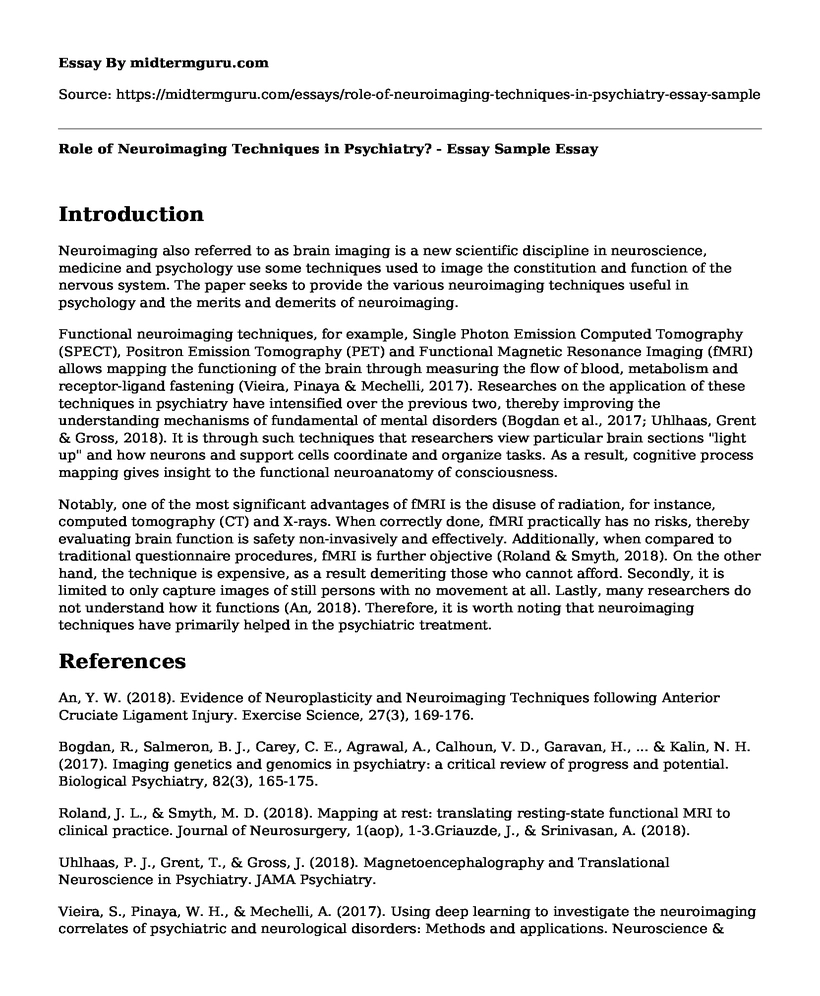Introduction
Neuroimaging also referred to as brain imaging is a new scientific discipline in neuroscience, medicine and psychology use some techniques used to image the constitution and function of the nervous system. The paper seeks to provide the various neuroimaging techniques useful in psychology and the merits and demerits of neuroimaging.
Functional neuroimaging techniques, for example, Single Photon Emission Computed Tomography (SPECT), Positron Emission Tomography (PET) and Functional Magnetic Resonance Imaging (fMRI) allows mapping the functioning of the brain through measuring the flow of blood, metabolism and receptor-ligand fastening (Vieira, Pinaya & Mechelli, 2017). Researches on the application of these techniques in psychiatry have intensified over the previous two, thereby improving the understanding mechanisms of fundamental of mental disorders (Bogdan et al., 2017; Uhlhaas, Grent & Gross, 2018). It is through such techniques that researchers view particular brain sections "light up" and how neurons and support cells coordinate and organize tasks. As a result, cognitive process mapping gives insight to the functional neuroanatomy of consciousness.
Notably, one of the most significant advantages of fMRI is the disuse of radiation, for instance, computed tomography (CT) and X-rays. When correctly done, fMRI practically has no risks, thereby evaluating brain function is safety non-invasively and effectively. Additionally, when compared to traditional questionnaire procedures, fMRI is further objective (Roland & Smyth, 2018). On the other hand, the technique is expensive, as a result demeriting those who cannot afford. Secondly, it is limited to only capture images of still persons with no movement at all. Lastly, many researchers do not understand how it functions (An, 2018). Therefore, it is worth noting that neuroimaging techniques have primarily helped in the psychiatric treatment.
References
An, Y. W. (2018). Evidence of Neuroplasticity and Neuroimaging Techniques following Anterior Cruciate Ligament Injury. Exercise Science, 27(3), 169-176.
Bogdan, R., Salmeron, B. J., Carey, C. E., Agrawal, A., Calhoun, V. D., Garavan, H., ... & Kalin, N. H. (2017). Imaging genetics and genomics in psychiatry: a critical review of progress and potential. Biological Psychiatry, 82(3), 165-175.
Roland, J. L., & Smyth, M. D. (2018). Mapping at rest: translating resting-state functional MRI to clinical practice. Journal of Neurosurgery, 1(aop), 1-3.Griauzde, J., & Srinivasan, A. (2018).
Uhlhaas, P. J., Grent, T., & Gross, J. (2018). Magnetoencephalography and Translational Neuroscience in Psychiatry. JAMA Psychiatry.
Vieira, S., Pinaya, W. H., & Mechelli, A. (2017). Using deep learning to investigate the neuroimaging correlates of psychiatric and neurological disorders: Methods and applications. Neuroscience & Biobehavioral Reviews, 74, 58-75.
Cite this page
Role of Neuroimaging Techniques in Psychiatry? - Essay Sample. (2022, Sep 22). Retrieved from https://midtermguru.com/essays/role-of-neuroimaging-techniques-in-psychiatry-essay-sample
If you are the original author of this essay and no longer wish to have it published on the midtermguru.com website, please click below to request its removal:
- Trauma Informed Parents: Analysis of the Website
- Procrastination Among the College Students - Essay Example
- Paper Example on Pamphlet Anxiety and OCD
- A Reflection on the Key Concepts Impacting on People with Mental Health Issues and their Support
- Article Analysis Essay on Culture as a Social Determinant of Mental and Behavioral Health
- Essay Sample on Identifying and Interpreting Emotional Expressions
- Depression: A Severe Medical Illness With Treatments Available - Essay Sample







